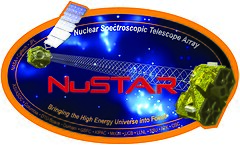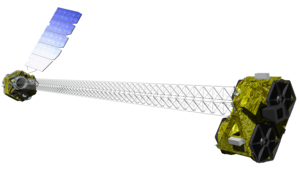Nuclear Spectroscopic Telescope Array
 Logo misji NuSTAR | |
| Inne nazwy | NuSTAR |
|---|---|
| Indeks COSPAR | 2012-031A |
| Państwo | |
| Zaangażowani | |
| Rakieta nośna | Pegasus XL |
| Miejsce startu | |
| Orbita (docelowa, początkowa) | |
| Nachylenie | 6° |
| Czas trwania | |
| Początek misji | 13 czerwca 2012 16:00 UTC |
| Wymiary | |
| Wymiary | 1,2 × 2,2 m; |
| Masa całkowita | 350 kg |
| Masa ładunku użytecznego | 171 kg |
Nuclear Spectroscopic Telescope Array (NuSTAR) – satelita astronomiczny agencji NASA zawierający teleskop kosmiczny przeznaczony do obserwacji wysokoenergetycznego promieniowania rentgenowskiego (w zakresie energii od 8 do 80 keV), a w szczególności do spektrometrii promieniowania gamma[1]. Będą to pierwsze tak dokładne pomiary w tym zakresie. Satelita należy do programu Small Explorer (SMEX).
Teleskop NuSTAR-a składa się z dwóch zestawów 133 koncentrycznych zwierciadeł z elastycznego szkła. Ponieważ promienie rentgenowskie wymagają dużych ogniskowych, teleskop wyposażony jest w 10-metrowy wysięgnik, który zostanie rozłożony tydzień po wyniesieniu na orbitę. Te i inne technologie zastosowane w satelicie pozwolą na badanie Wszechświata z większą niż dotychczas rozdzielczością i czułością. W ciągu dwóch lat NuSTAR ma wykonać przeglądy nieba, na których uwidoczni m.in. czarne dziury i pozostałości po supernowych. Satelita będzie prowadził również obserwacje heliosfery i spróbuje zweryfikować jedną z hipotez odnoszących się do ciemnej materii[2].
Teleskop został wyniesiony w przestrzeń kosmiczną 13 czerwca 2012 przez rakietę Pegasus XL (startującą z powietrza po wyniesieniu przez zmodyfikowany do tego celu samolot Lockheed L-1011 „Stargazer”[3]).
Przypisy
- ↑ About NuSTAR (ang.). NASA. [dostęp 2012-06-08].
- ↑ Hubert Bartkowiak: „NuSTAR dotarł do Vandenberg” (pol.). Kosmonauta.net, 2012-01-28. [dostęp 2014-11-03].
- ↑ NuSTAR to open X-ray eyes on universe (ang.). astronomy.com, 2012-03-07. [dostęp 2012-06-12].
Linki zewnętrzne
- Oficjalna strona misji NuSTAR (ang.). Caltech. [dostęp 2012-06-08].
- NASA: Nuclear Spectroscopic Telescope Array, or NuSTAR Press Kit (ang.). czerwiec 2012. [dostęp 2013-01-06].
Media użyte na tej stronie
The flag of Navassa Island is simply the United States flag. It does not have a "local" flag or "unofficial" flag; it is an uninhabited island. The version with a profile view was based on Flags of the World and as a fictional design has no status warranting a place on any Wiki. It was made up by a random person with no connection to the island, it has never flown on the island, and it has never received any sort of recognition or validation by any authority. The person quoted on that page has no authority to bestow a flag, "unofficial" or otherwise, on the island.
Artist's concept of NuSTAR on orbit. NuSTAR has a 10-m (30') mast that deploys after launch to separate the optics modules (right) from the detectors in the focal plane (left). The spacecraft, which controls NuSTAR's pointings, and the solar panels are with the focal plane. NuSTAR has two identical optics modules in order to increase sensitivity.
NASA's Nuclear Spectroscopic Telescope Array (NuSTAR) will be the first sensitive, focusing high energy X-ray telescope to orbit the Earth. NuSTAR will investigate the hottest regions in the Universe, studying sources ranging from neutron stars to supernovae to black holes and the Sun. Because of its focusing optics and improved detectors, NuSTAR will be sensitive to objects one hundred times fainter than any previous mission working at these energies. Developed by an international team, this Small Explorer mission will launch in 2012, and spend at least two years observing the high energy Universe.



